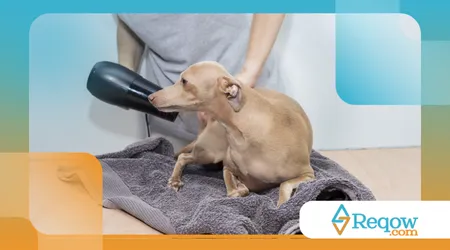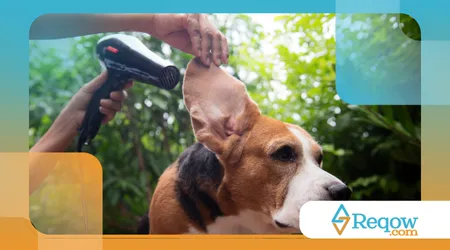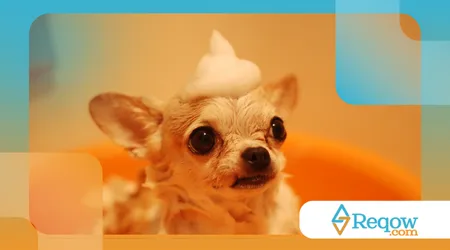How to get your dog used to the dryer after bathing

Getting your dog used to the dryer after bathingBathing dogs can be a journey of patience, especially when the dreaded blow-dry time arrives.
Advertisements
For many owners, the shrill sound and strong wind present a challenge.
However, it's possible to make this moment calm and even enjoyable. The key to success is conditioning.
Aversion to the dryer is a common behavior, but it's not destiny. Most dogs dread the experience.
The good news is that with the right approaches, the situation can change quickly.
Advertisements
Fear has a scientific explanation. Dogs' auditory sensitivity is much more acute than ours.
The high-frequency sound of a hairdryer can be annoying. The best strategy is to associate the appliance with something positive.
Start the process gradually, away from bath time. The goal is for your dog to ignore the dryer. To do this, you'll associate it with treats.
Understanding Canine Behavior Getting Your Dog Used to the Dryer After Bathing
Classical conditioning is the best approach. The concept is simple: if the dryer is turned on, good things happen. The treat must be irresistible, something he rarely eats.
Don't try anything drastic. The first step is the most important. Leave the dryer turned off on the floor. If he sniffs it or approaches it, give him the treat.
Progression should be in small steps. Repeat the previous step several times a day for a few days. Give a treat for each approach.
Your dog must understand that the presence of the dryer means a reward. Repetition is the foundation of learning.
Practical and Intelligent Techniques for Conditioning
Now, the next step. Leave the device on, but at a safe distance. The sound should be low. If your dog doesn't react, reward him.
If there's any sign of fear, stop immediately. The goal isn't to scare the dog. The process can take weeks or even months. Each dog has its own pace.
Read more: How to Create a Bathing Schedule for Short and Long Haired Dogs
A study by Dr. Stanley Coren, published in the journal Psychology Today in 2011, showed that positive reinforcement is the most effective method for training dogs, surpassing punitive methods in 85% of the successful cases.
This information reinforces the importance of a gentle approach.
A practical example: If your dog gets startled, start again, at a greater distance. The sound must be tolerable. Slowly increase the proximity.
Once he's comfortable with the dryer running at a distance, you can start using it for short periods. Point the air at his body, never his face.

The Bath Strategy: Incorporating the Blow Dryer into Your Routine
With your dog already accustomed to bathing, bath time won't be a struggle anymore. Start with a towel to remove excess water. This will reduce drying time.
Turn the dryer on the lowest heat setting and the lowest speed. You want him to not get scared. Start drying his paws.
Don't direct the hot air at the same spot for too long, as this can burn your dog's skin. Keep the device moving constantly.
Find out more: Can dogs identify good and bad people just by smell? Studies show that they can.
If he behaves well, praise him profusely. Give him treats during drying, at short intervals. This reinforces good behavior.
They're like sponges, absorbing our emotions. If you're nervous, they will be too. Calmness is contagious.
Essential Tips for a Successful Process
| Tip | Objective |
| Use a quiet dryer | Reduce noise impact |
| Choose the lowest temperature | Avoid burns |
| Reward at every step | Reinforce positive behavior |
| Create a safe environment | Promote comfort and confidence |
Don't forget patience. Each session should be short. Progress may be slow, but it's lasting.
A notable example of success is the case of a Labrador named Max.
He was terrified of dryers. His tutors, after six months of training, managed to get your dog used to the dryer after bathing.
The process was slow, with short daily sessions of just one minute.
Look how interesting: Bizarre pet behaviors explained: when chewing on walls or licking the floor isn't just an "animal thing"
Another crucial point is consistency. Training must be continuous. Don't expect success to come in a single session.
When the process is complete, he will no longer fear the dryer.
What was once a struggle will become a ritual. After all, why should a moment of care be a source of stress?
Remember: the ultimate goal is to make the experience of drying your dog an extension of affection and care, strengthening the bond between you.
The reward is having a clean, smelling and, above all, happy animal.
The journey to get your dog used to the dryer after bathing It's an act of love. An animal that trusts you is a happy animal. Training isn't an imposition, it's an invitation.

The keys to getting your dog used to the dryer after bathing
Patience and positive reinforcement are key to getting your pet to see the dryer not as a monster, but as something harmless.
Following the guide above will help you build a trauma-free hygiene routine, strengthening trust between owner and pet.
The task of get your dog used to the dryer after bathing is a proof of dedication.
Your dedication will transform bath time from a stressful activity into a moment of affection and care.
Remember, the time and love you invest in your dog will be rewarded with a stronger, happier relationship.
Frequently Asked Questions about Getting Your Dog Used to the Hair Dryer After Bathing
1. Can I use my conventional hair dryer?
Yes, but with caution. Human hair dryers can have very high temperatures and power.
If your dryer doesn't have a temperature control, keep it a safe distance away to prevent burning your pet's skin.
2. What should I do if my dog doesn't accept the dryer at all?
It's important to be patient. Some breeds are more sensitive.
Consider using absorbent towels and letting your dog's coat dry naturally. If necessary, consult a veterinarian or pet groomer.
3. How do I know if my dog is scared?
Signs of fear vary. He may growl, hide, tremble, or try to run away.
4. What should I do if my dog's skin becomes irritated after drying?
Stop using the dryer immediately and check for signs of burning or irritation.
Use the lowest heat setting and don't keep the dryer in one place. If irritation persists, seek veterinary help.
Other sources: Learn how to train dogs that get stressed during bath time
